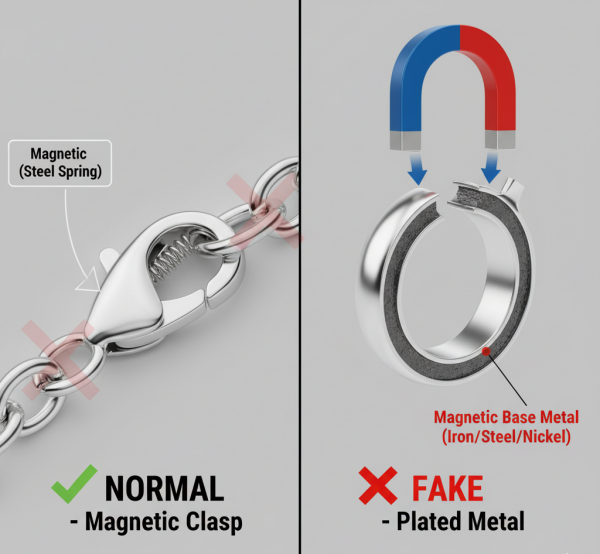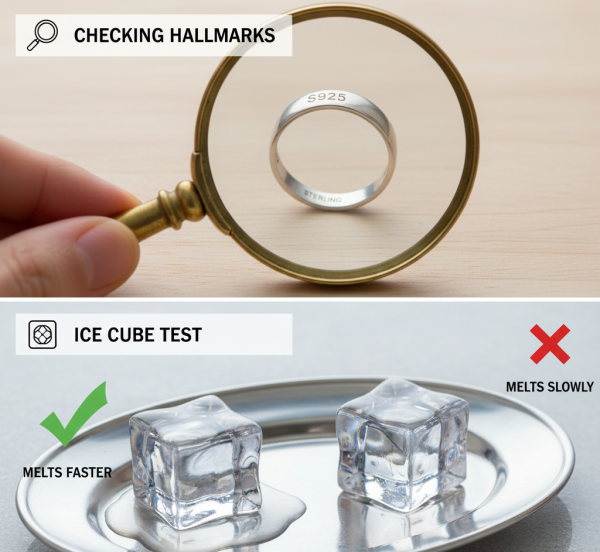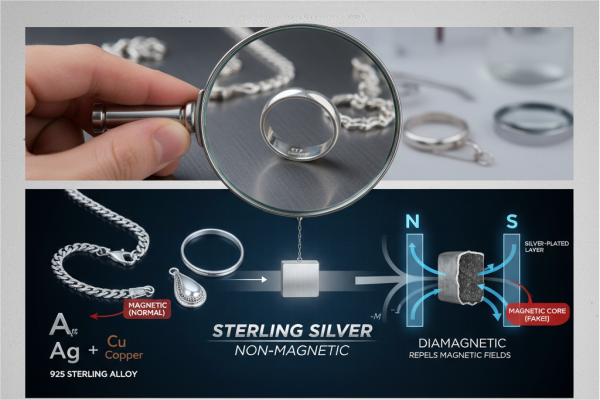No, sterling silver is not magnetic.
Hold a magnet to genuine sterling silver jewelry. You won’t feel any pull. This basic fact gives you one of the quickest ways to check if your silver is real.
People ask “is sterling silver magnetic” all the time. Curious buyers, experienced jewelers – everyone wants to know. The answer is straightforward: no. But there’s more to the story. A magnetic reaction doesn’t always mean your whole piece is fake. It does tell you something important about what’s inside.
This guide explains the science behind silver’s properties. You’ll learn how to do an accurate magnet test step by step. We’ll help you read the results like a pro. Our goal is simple: give you the knowledge to spot real sterling silver and catch fakes.
Table of Contents
Silver's Magnetic Properties
Why does the magnet test work? It comes down to silver’s basic structure and the metals mixed with it.
The Non-Magnetic Nature
Pure silver (marked as .999) doesn’t stick to magnets. Scientists call silver a diamagnetic metal.
Sterling silver is the jewelry standard. It’s marked “925” and contains 92.5% pure silver. The other 7.5% is usually another metal added for strength. Since it’s mostly silver, sterling silver stays non-magnetic.
What is "Diamagnetic"?
Diamagnetism is a weak type of magnetism. All materials have it, but it’s usually too faint to notice.
When you put a diamagnetic material near a magnetic field, it creates its own tiny opposing field. This causes slight repulsion, not attraction.
Think of pushing two magnet north poles together. They push apart. Diamagnetism works the same way but much, much weaker. The push-back is so subtle you can’t feel it with a regular magnet.
The Role of Copper
Sterling silver must be 92.5% pure silver. The remaining 7.5% is an alloy metal. For centuries, copper has been the go-to choice.
Here’s why this matters for magnet testing:
- Silver (Ag): Diamagnetic. Pushes away from magnetic fields.
- Copper (Cu): Also diamagnetic. Also pushes away from magnetic fields.
Mix two diamagnetic metals and you get a diamagnetic alloy. Adding copper to make sterling silver doesn’t create any magnetic pull. Real “925” sterling silver won’t stick to a magnet.
Why Your Jewelry Reacts

This confuses people most. You’ve heard sterling silver isn’t magnetic, but your silver chain jumps right to a magnet. This moment tells you something important. Here are the clear reasons why this happens.
Reason 1: The Clasp
We see this constantly. You test a beautiful sterling silver necklace with a magnet. Nothing happens along the chain. Then you reach the clasp and it snaps right to the magnet.
This is extremely common. Usually, it’s not a problem. The chain is likely real sterling silver, but the clasp isn’t.
Small working parts like clasps need internal springs. Spring-ring and lobster clasps especially. These springs must be hard and tough to work thousands of times without breaking. Steel works perfectly for this. But steel is magnetic.
Manufacturers use steel springs even in high-quality sterling silver jewelry. A silver spring would be too soft and break quickly. So if only the clasp is magnetic, that’s normal construction, not a fake. Always test the main part separately – the chain links or pendant – away from the clasp.
Reason 2: It is Silver-Plated
If the main body pulls to a magnet – the chain, pendant, or ring band – you almost certainly have a fake. This is the most common sign of counterfeit silver.
The item is probably made from cheap, magnetic base metal. Then it’s coated with an ultra-thin layer of silver. This is called silver-plating.
The magnet isn’t reacting to the silver coating. It’s pulling the core metal underneath. Common magnetic base metals include:
- Iron
- Steel
- Nickel
- Cobalt
These metals are ferromagnetic. They’re strongly attracted to magnets. The thin silver coating is just for looks and has little value. For deeper information on coating processes, check resources from the Society of Manufacturing Engineers (SME).
Reason 3: A Poor-Quality Alloy
The international standard for sterling silver is 92.5% silver and 7.5% copper. But fraudulent or cheap manufacturers might use other metals.
If a piece says “925” but has a slight magnetic pull, it could contain nickel or iron in the alloy. Nickel is ferromagnetic. Even a small amount can cause noticeable attraction.
This is deceptive practice. It devalues the piece and creates other problems. Nickel commonly causes skin allergies – rashes and irritation for many people. This is another major reason why reputable jewelers stick to copper for sterling silver alloys. If your “silver” jewelry causes skin reactions and is magnetic, it likely contains nickel and isn’t genuine sterling silver.
The Magnet Test Guide

The magnet test is simple. But doing it right is key to reliable results. Follow these steps for a definitive home test. This is the most effective initial screening method you can use.
Step 1: Get the Right Tool
Your magnet choice is critical. A weak magnet, like a refrigerator magnet, might not detect small amounts of magnetic metal in a clasp or poor alloy. It could give false results, making you think a fake piece is real.
For conclusive testing, use a strong rare-earth magnet. The most common type is a neodymium magnet.
These magnets are incredibly powerful for their size. They create strong enough magnetic fields for clear results. They’re essential tools for anyone buying or selling jewelry. For reliable results, we recommend a high-quality neodymium magnet, which provides the strength needed for conclusive testing. They’re affordable and widely available.
Step 2: Perform the Test Correctly
Once you have your neodymium magnet, follow this professional procedure.
First, place the jewelry on a flat, clean, non-metal surface like a wooden table or cloth. This prevents interference.
Hold the jewelry steady with one hand. With the other, bring the neodymium magnet very close to the item. Don’t just quickly tap it.
Slowly move the magnet over all different parts of the piece. For a necklace, test the chain links, then the pendant bezel, then the bail (the loop holding the pendant), and finally test the clasp separately. For a ring, test multiple points around the band. This systematic approach ensures you don’t miss any magnetic components.
Step 3: Interpret Your Results
How the item reacts – or doesn’t – tells you everything. There are three possible outcomes. Each means something different. We’ve broken them down in a simple table.
Result | What It Likely Means | Next Steps |
No Reaction at All | The item is likely solid sterling silver, fine silver, or another non-magnetic metal (like aluminum, copper, or gold). This is the best possible result and a very good sign of authenticity. | This piece passes the magnet test. Proceed to other verification methods like checking for hallmarks for full confirmation. |
Strong, Immediate Attraction | The item is almost certainly not sterling silver. The core is a ferromagnetic metal like iron, steel, or nickel. It is most likely a silver-plated fake. | This piece has failed the magnet test. It is not genuine sterling silver. |
Weak, Slight Pull or “Drag” | This is the most nuanced result. It could mean the clasp contains a steel spring, the piece is a poor-quality alloy with some nickel, or (very rarely) you are feeling a slight effect with an extremely powerful magnet. | Isolate the reaction. If only the clasp is magnetic, the rest of the piece is likely genuine. If the whole piece has a slight drag, it is suspect and likely not true sterling silver. |
A Critical Warning
The magnet test is excellent for eliminating fakes. But it’s not 100% foolproof on its own.
Why? Because smart counterfeiters can use non-magnetic base metals for fakes. Metals like pewter, zinc, or aluminum aren’t magnetic, so they’ll pass the magnet test. However, these metals aren’t silver and have very little value.
This is why the magnet test should be your first step, not your only step. If a piece passes the magnet test, move on to other verification methods to be completely sure. For more information on silver’s basic properties, check authoritative sources like the U.S. Geological Survey (USGS).
More Verification Methods

Once your piece passes the magnet test, you can boost your confidence with a few more simple checks. Combining these methods creates a much stronger authentication process.
1. Look for Hallmarks
A hallmark is an official mark showing metal purity. For sterling silver, look for a small stamp that says:
- “925”
- “Sterling”
- “STER”
- “SS”
These marks are usually in discreet places. Inside a ring band, on the back of a pendant, on a small tag near the clasp, or on the clasp itself. No hallmark is a major red flag.
But be aware – these stamps can be faked. A counterfeit piece can easily be stamped with “925.” That’s why hallmarks should be used with other tests. A hallmark on a piece that is magnetic is a dead giveaway that the piece is fake. For more on quality marks, check resources from industry authorities like Jewelers of America (JA).
2. The Ice Test
This surprisingly effective test uses a unique silver property: thermal conductivity. Silver has the highest heat transfer rate of any common metal, even higher than copper. It moves heat incredibly quickly.
The test is simple:
- Take two ice cubes.
- Place one ice cube on the silver item you’re testing.
- Place the other ice cube on a neutral surface at room temperature, like a countertop or glass plate.
Watch what happens. The ice on the silver item should start melting almost instantly, much faster than the other cube. It looks like the silver is hot, even though it’s at room temperature. This happens because silver rapidly pulls heat from the air and transfers it directly into the ice. A fake made of steel, pewter, or nickel won’t have this dramatic effect. To learn more about the science, read about thermal conductivity on educational sites like Physics.org.
3. Professional Options
For highly valuable, antique, or questionable items, professional verification is the best choice.
One method professionals use is an acid test. This involves scratching the item on a test stone and applying nitric acid to the streak. The color reaction indicates metal purity. We strongly advise against doing this yourself. The acids are highly dangerous if handled wrong, and the test can damage your jewelry if done incorrectly.
The safest and most definitive option is taking the piece to a reputable local jeweler or certified appraiser. They have the experience and equipment to determine exact metal content without damaging your item.
A Guide for Crafters
For jewelers, DIY crafters, and serious hobbyists, understanding magnetic properties of materials goes beyond simple authentication. It affects your sourcing, designs, and even your tools.
Sourcing Reputable Silver
When buying raw materials like sterling silver wire, sheet, or bezel strips, you’re buying based on trust.
- Always vet your suppliers. A reputable supplier guarantees their sterling silver is a .925 alloy of silver and copper only.
- When receiving new material, do a quick magnet test on a scrap piece. This simple quality control step saves you from accidentally using substandard materials in your work.
Why Findings Matter
We’ve established that steel springs in clasps are standard. Understanding the details can elevate your craft.
- For high-end, custom pieces, some clients may request all-sterling components, including specialty-made clasps without steel parts. Knowing the difference lets you meet this demand.
- When working with small magnetic components, use the right tools. Trying to handle a tiny steel spring with steel tweezers is incredibly frustrating as it sticks to your tool. Using brass or titanium tweezers, which are non-magnetic, makes assembling and repairing clasps much easier.
- For complex projects, understanding different magnet properties can be crucial. Our resource on magnetic applications provides deeper insights for workshop use.
Understanding Other Alloys
The silver world includes more than just traditional sterling.
- Fine silver (.999) is 99.9% pure silver. It’s very soft and, like pure silver, is diamagnetic and not attracted to magnets.
- Argentium silver is a modern sterling alloy using germanium instead of some copper. This makes it highly tarnish-resistant. It’s also non-magnetic.
- Coin silver and other historical alloys can have varying silver content. Their magnetic properties depend on the other metals in the alloy. To learn more about different silver purity types, visit bullion dealers like APMEX, which often have detailed educational resources.
Your First Line of Defense
Back to our core question: is sterling silver magnetic? The answer remains a firm no. Genuine sterling silver is non-magnetic, and any attraction to a magnet should be seen as a red flag requiring immediate investigation. A strong pull clearly indicates a fake, while a slight pull often points to a steel component like a clasp spring or poor-quality alloy.
The magnet test is the fastest, cheapest, and most accessible tool you have. It’s your first line of defense against the growing counterfeit jewelry market. Combine it with other simple checks, like looking for hallmarks and trying the ice test, and you can shop, sell, and create with much higher confidence.
Whether you’re a hobbyist, collector, or curious consumer, having the right tools is key. For a wide selection of powerful magnets suitable for testing and various other projects, explore our full collection at CNM Magnet.
We are a manufacturer specializing in the research and development of magnets with years of industry experience. Our product offerings include NdFeB magnets, ferrite magnets, and custom magnetic components. Our goal is to provide high-quality magnetic solutions to customers worldwide, and we also offer OEM/ODM customization services. If you have any questions about magnets or custom applications, please feel free to contact our team of experts.
Facebook
Twitter
LinkedIn
WhatsApp

